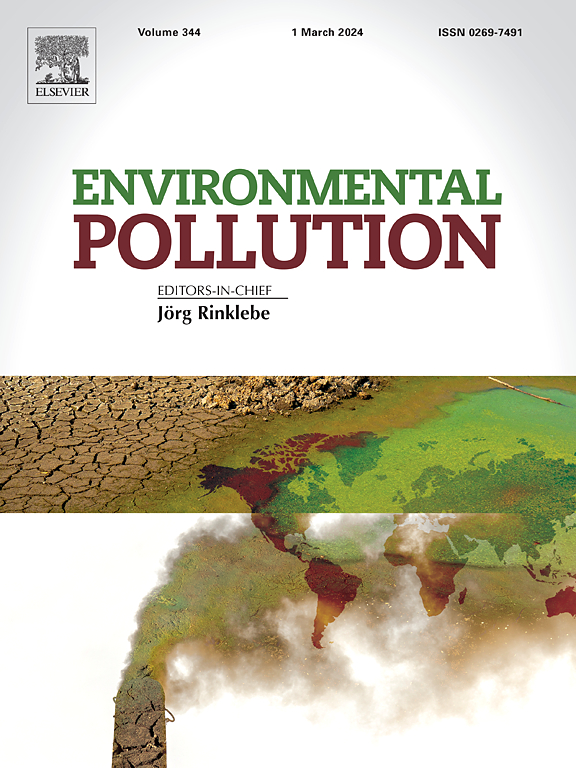香烟过滤嘴中的微塑料:对某些陆生和水生无脊椎动物的比较影响
IF 7.3
2区 环境科学与生态学
Q1 ENVIRONMENTAL SCIENCES
引用次数: 0
摘要
香烟过滤嘴含有塑化醋酸纤维素,这是一种被归类为生物塑料的合成聚合物。它们是微塑料(MPs)的重要来源,特别是微纤维和相关化学品,但它们对生物,特别是土壤无脊椎动物的影响尚未得到充分研究。本研究考察了从烟熏香烟过滤嘴(SCF-MPs)和未烟熏香烟过滤嘴(UCF-MPs)中研磨出来的MPs对陆生无脊椎动物(Porcellio scaber, Tenebrio molitor)和水生无脊椎动物(Daphnia magna, Brachionus calyciflorus)的影响。SCF-MPs和UCF-MPs的尺寸分别为9.06±4.1 μm和12.71±6.82 μm。两种样品都含有三乙酸乙酯和潜在有毒金属,而SCF-MPs还含有尼古丁和大量微量有机化合物。虽然暴露于SCF-MPs或UCF-MPs(土壤中高达1.5% MPs, w/w)对陆地无脊椎动物的生存没有影响,但观察到一些生理反应。这些变化包括免疫参数、能量相关生物标志物水平、谷胱甘肽s转移酶和乙酰胆碱酯酶活性的改变。两种类型的MPs对水生无脊椎动物都有急性毒性,降低了萼花小蠊(暴露48小时后每种颗粒10 mg L-1)和大蠊(暴露48小时后每种颗粒100 mg L-1)的存活率。SCF-MPs通常比UCF-MPs造成更明显的影响。这项研究强调需要有效的环境管理来解决吸烟和未吸烟的香烟过滤嘴问题。本文章由计算机程序翻译,如有差异,请以英文原文为准。


Microplastics from cigarette filters: comparative effects on selected terrestrial and aquatic invertebrates
Cigarette filters comprise plasticised cellulose acetate, a synthetic polymer categorized as bioplastic. They represent a significant source of microplastics (MPs), in particular microfibers, and associated chemicals, yet their impact on organisms, especially soil invertebrates, is not well-studied. This research examines the effects of MPs milled from smoked (SCF-MPs) and unsmoked cigarette filters (UCF-MPs) on terrestrial invertebrates (Porcellio scaber, Tenebrio molitor) and aquatic invertebrates (Daphnia magna, Brachionus calyciflorus). SCF-MPs and UCF-MPs were found to be 9.06 ± 4.1 μm and 12.71 ± 6.82 μm in size, respectively. Both samples contained triacetin and potentially toxic metals, while SCF-MPs also contained nicotine and a larger number of trace organic compounds. While exposure to SCF-MPs or UCF-MPs (up to 1.5% MPs, w/w in soil) did not affect the survival of either terrestrial invertebrate, several physiological responses were observed. These included changes in immune parameters, energy-related biomarker levels, and altered glutathione S-transferase and acetylcholinesterase activities. Both types of MPs were acutely toxic to aquatic invertebrates, reducing the survival rates of B. calyciflorus (10 mg L-1 of either particle after 48h exposure) and D. magna (100 mg L-1 of SCF-MPs after 48h exposure). SCF-MPs generally caused more pronounced effects than UCF-MPs. This study highlights the need for effective environmental management to address both smoked and unsmoked cigarette filters.
求助全文
通过发布文献求助,成功后即可免费获取论文全文。
去求助
来源期刊

Environmental Pollution
环境科学-环境科学
CiteScore
16.00
自引率
6.70%
发文量
2082
审稿时长
2.9 months
期刊介绍:
Environmental Pollution is an international peer-reviewed journal that publishes high-quality research papers and review articles covering all aspects of environmental pollution and its impacts on ecosystems and human health.
Subject areas include, but are not limited to:
• Sources and occurrences of pollutants that are clearly defined and measured in environmental compartments, food and food-related items, and human bodies;
• Interlinks between contaminant exposure and biological, ecological, and human health effects, including those of climate change;
• Contaminants of emerging concerns (including but not limited to antibiotic resistant microorganisms or genes, microplastics/nanoplastics, electronic wastes, light, and noise) and/or their biological, ecological, or human health effects;
• Laboratory and field studies on the remediation/mitigation of environmental pollution via new techniques and with clear links to biological, ecological, or human health effects;
• Modeling of pollution processes, patterns, or trends that is of clear environmental and/or human health interest;
• New techniques that measure and examine environmental occurrences, transport, behavior, and effects of pollutants within the environment or the laboratory, provided that they can be clearly used to address problems within regional or global environmental compartments.
 求助内容:
求助内容: 应助结果提醒方式:
应助结果提醒方式:


